Choosing the Best Foot Pedal for Your Sewing Machine
2022-12-06
A sewing machine is a great tool for repairing damaged garments, adding extra features to items, or getting creative and fashioning a complete piece of clothing or accessory from start to finish.
Though sewing machines provide so much opportunity for fun and creativity, it takes time to learn how to use your machine properly and get the most out of it.
One reason why sewing machine projects can be intimidating for new sewers is the use of presser feet, which are sewing machine attachments that help sewers to achieve specific details of their projects much more neatly and efficiently than they would be able to do by hand.
Not sure which presser foot pedal to choose? Understanding some of the more common types of sewing machine presser feet and what they’re used for will help you to make your decision.
Here are a few of the most popular types of presser feet and what they’re designed to do for your project:
Zigzag (Standard) Foot
As its name suggests, the zigzag or standard presser foot is a staple among amateur and pro sewers alike. In fact, many sewing machines come with a zigzag foot included, since this presser foot can be a useful tool for a wide variety of projects.
The zigzag foot can successfully perform zigzag and straight stitches in addition to satin stitches, overcasting stitches, and decorative stitches. Though some fabrics may not be ideal for zigzag feet, this tool can be used on many of the most common fabrics used in DIY projects.
Zipper Foot
The zipper foot is designed to help create zippers neatly and safely on sewing projects, and sewing machines often come with a zipper foot included as well. Zipper feet usually have a gap on either side where you will position your zip tape in order to apply the correct side of your zipper.
Since zippers are a special feature of clothing and other items that need to be just as useful as they are correctly placed, it’s very helpful to use a zipper foot in order to make sure you don’t make a mistake during the process.
Straight Stitch Foot
Though zigzag stitches can be effective and sturdy for many types of fabrics, finer fabrics like chiffon may not hold zigzag stitches quite as well. If you work with fine fabrics often, you’ll need a straight stitch foot to successfully complete your project.
Straight stitch presser feet have a smaller gap in which to feed the fabric than a standard foot, which helps to avoid the fabric getting pulled under the needle plate during sewing. Additionally, more pressure is applied to the feed dogs, which allows the fine fabric to be fed gently through the machine.
Walking Foot
Walking feet are specialized sewing machine presser feet that can be used for a variety of different projects, including quilting, patchwork, and dressmaking.
The walking foot helps your sewing machine to feed your fabric through very evenly, which is useful for delicate detailing, like patchwork design, or working with multiple layers of fabric when creating a quilt. The walking foot makes sure that every layer of fabric is fed through at the same rate so that they are stitched at the perfect point.
Buttonhole Foot
Just like zippers, buttonholes are a crucial part of a sewing project to get right, as they need to be just as useful as they are neat looking. Once you measure and mark down the button sizing on your fabric, the buttonhole foot will help you to create a perfectly sized hole while also establishing thick seams to prevent fraying.
Quarter-Inch Seam Foot
A quarter-inch seam is a common seam width for many different projects, and the quarter-inch seam foot helps to ensure that your seams are the perfect width. Though this foot will help to create accurate quarter-inch seams, it’s still important that your fabric be cut out correctly.
Find Your Ideal Presser Foot and More at GoldStar Tool
We’re here to help everyone from the beginning DIY-er to the seasoned sewer find all the tools and fabrics they need to succeed. Visit us at GoldStar Tool today to find your perfect presser foot and any other sewing machine features you might need!





